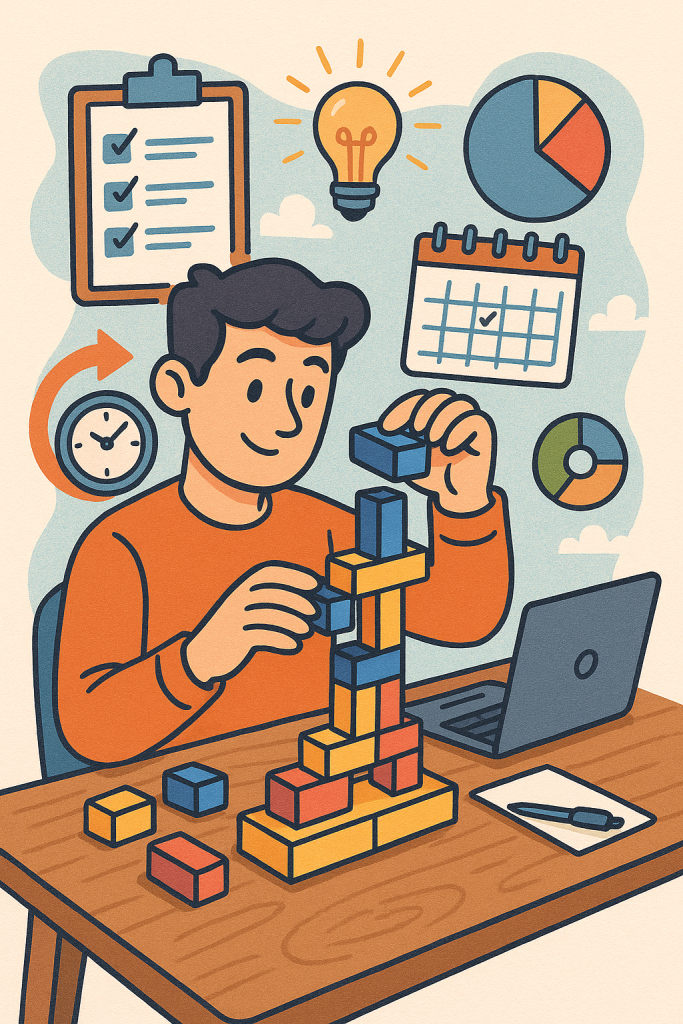In an era of AI-driven workflows and hybrid teams, how to build a flexible productivity framework is essential for staying agile, efficient, and empowered.

What Makes a Productivity Framework Truly Flexible?
A flexible productivity framework adapts to:
- Personal rhythms – acknowledging individual peaks (e.g., 11 a.m. on Mondays) and troughs.
- Work environments – supporting remote, hybrid, office, and even nomad setups.
- Emerging tools – from AI assistants to wearable tech.
A rigid “9-to-5 + fixed tools” strategy simply can’t navigate today’s dynamic demands.
Why 2025 Is a Turning Point
1. AI Becomes Productivity’s Backbone
A 2025 survey found 62 % of knowledge workers want AI for routine tasks like emails and note-taking. Early adopters report boosting output and passion by offloading mundane work.
2. Hybrid Work Is the Norm
Approximately 74 % of companies now use hybrid or flexible systems—with flexible hours and compressed workweeks gaining traction worldwide.
3. Personalized Workflows
The concept of “chronoworking” lets workers align schedules with personal body clocks — increasingly adopted in Europe and soon Australia.
Building Blocks: 5 Steps to Create Your Framework
Step 1: Understand Core Components
Divide your framework into workflow, tools, and policies.
- Workflow: How you sequence tasks: asynchronous work, deep-focus blocks, or team huddles.
- Tools: Digital assistants (AI note-takers), project trackers (Asana, Trello), scheduling apps (calendar with buffer zones).
- Policies: Define “core hours”, meeting-free reflexes, and performance benchmarks.
Step 2: Map Your Ecosystem
Tailor to your context:
- Remote? Prioritize async tools (Slack, Loom).
- Hybrid? Use desk reservation systems (Officely).
- Office-heavy? Blend with remote days and core hours.
Ensure policies are clearly communicated and supported by leadership.
Step 3: Integrate Intelligent Assistants
AI-powered tools can automate drafting, summarizing, scheduling, and context-aware nudges. A recent academic study showed AI agents raise both productivity and well-being.
Step 4: Personalize Your Schedule
Offer options like:
- Chronoworking to match individual energy cycles.
- Compressed weeks (4×10 hrs) — high adoption in Japan and Asia-Pacific .
- Focus blocks or “micro-sprints” during core hours.
Step 5: Measure Impact and Adjust
Use outcome-based KPIs instead of hours-in-seat. Track metrics like:
- Task completion
- Time-to-feedback
- Employee engagement
Review quarterly and adapt.
Trend Spotlight: AI + Wearables + Metrics
- AI agents triage and synthesize information autonomously.
- Wearables measure biometrics, fatigue, and productivity to feed personalized nudges .
- Productivity analytics—via dashboards tied to OKRs—translate activity into real-time insights .
This tech-driven loop empowers smart, adaptive productivity.
Framework Checklist: What to Include
| Component | Description |
|---|---|
| Core Hours | Overlapping work-window aligning remote/home/in-office preferences. |
| Focus Blocks | Designated meeting-free periods (e.g., 9–11 a.m.) for deep work. |
| Asynchronous Channels | Tools like Slack/Loom for updates independent of live presence. |
| AI Assistants | For summarizing meetings, drafting emails, task reminders. |
| Measurement Metrics | Output-based goals, not seat-time logs. |
| Feedback Loops | Iterative surveys and manager check-ins. |
Case Study: Tokyo Government’s 4-Day Week
Tokyo’s public sector shifts to a 4-day workweek (80 % hours, 100 % pay) from April 2025.
Results from similar trials:
- Fewer low-value meetings
- 4.5 % higher satisfaction; 6.7 % more engagement
This demonstrates how compressed work models can improve both happiness and output.
Common Pitfalls & How to Avoid Them
- Perfection paralysis – Start small with pilot teams.
- One-size-fits-all – Let individuals choose schedules.
- Hidden presenteeism – Reinforce output over hours.
- Tech without training – Educate all users on new tools early.
Future Outlook: What’s Next for Flex Productivity?
- “Work 4.0” frameworks focusing on human-led automation and safety.
- Smart offices — IoT and cloud systems for highly adaptable spaces.
- XR and VR meetings for deeper collaboration across geographies.
By staying ahead of these trends, your productivity framework can evolve seamlessly for years to come.
In Summary
To build a flexible productivity framework, lay a foundation with:
- Clear core hours and focus blocks
- AI tools that automate routine tasks
- Personalized schedules—chronoworking or compressed weeks
- Smart measurement based on outcomes
- Iterative adjustments based on data and feedback
This isn’t just “remote work 2.0”—it’s a future-ready system that boosts performance, supports well-being, and adapts with your team’s needs. Implement early, learn fast, and keep evolving.
References
Clear, J. (2018) Atomic Habits: An Easy & Proven Way to Build Good Habits & Break Bad Ones. New York: Avery Publishing. https://jamesclear.com/atomic-habits
Duhigg, C. (2012) The Power of Habit: Why We Do What We Do in Life and Business. New York: Random House. https://charlesduhigg.com/the-power-of-habit/
Bailey, C. (2021) ‘How to Build a Productivity System That Works for You’. Harvard Business Review. Available at: https://hbr.org (Accessed: 17 June 2025).






